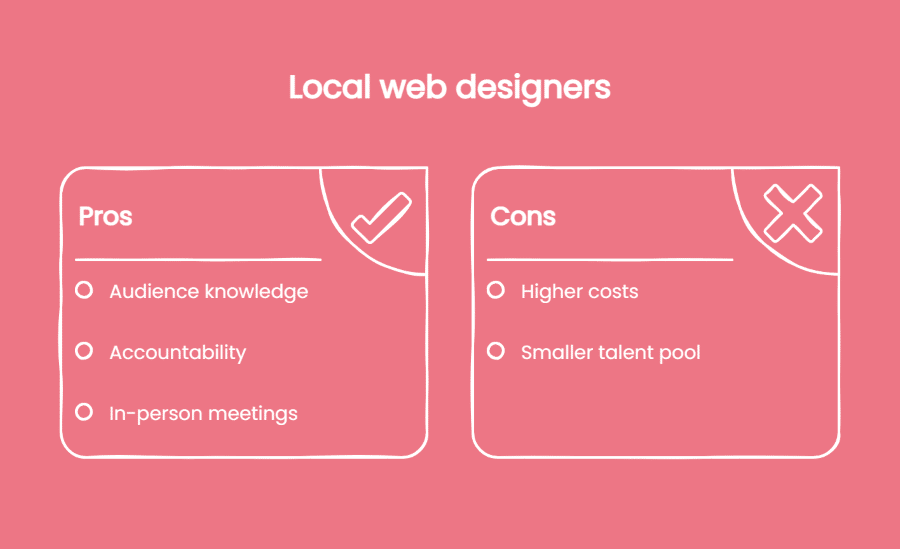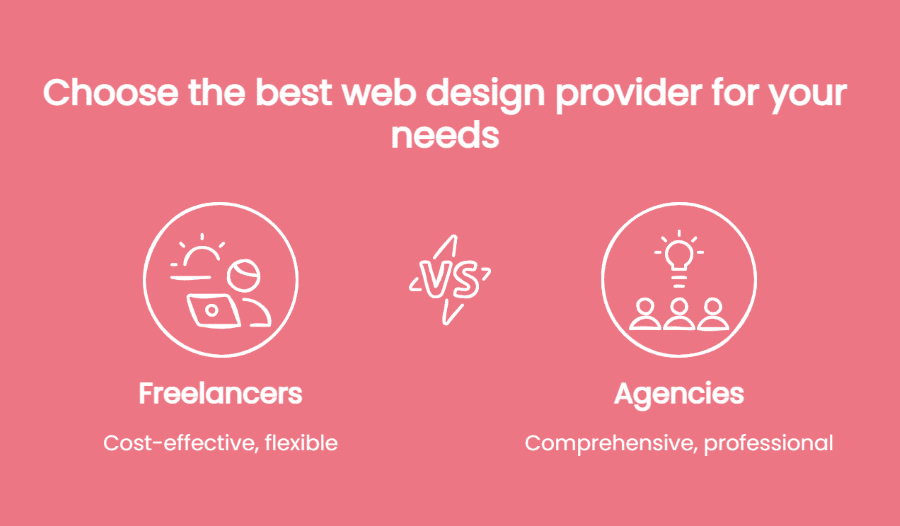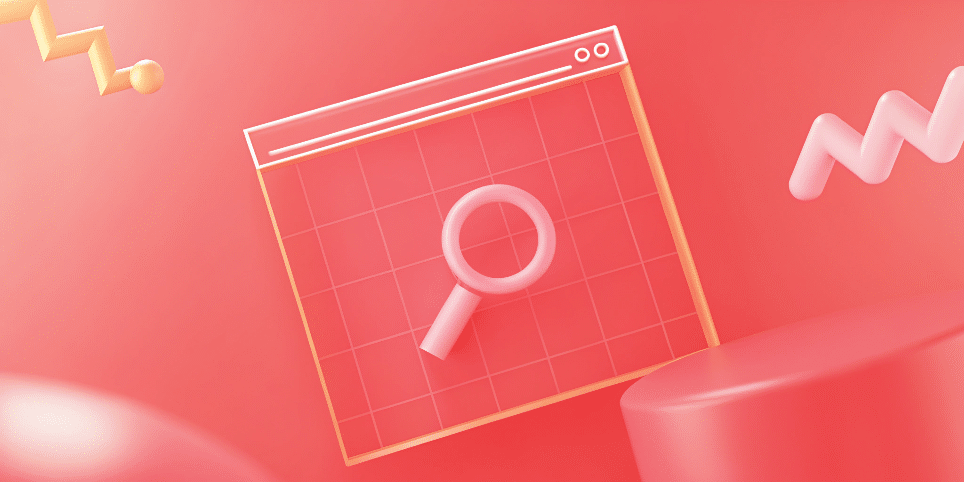TL;DR: Hiring a website designer in Australia can cost between $500 for a simple site and $20,000+ for larger projects. This guide explains where to find designers, how to assess their work, and what to expect when choosing between freelancers and agencies.
What to know
- Budget Range: Expect to pay $500-$5,000 for small business websites, $5,000-$15,000 for professional sites
- Finding Methods: Use Google Maps for local designers, Bark.com for quotes, Upwork for vetted talent
- Portfolio Check: Look for 5+ recent projects, mobile responsiveness, and industry-specific experience
- Location Matters: Local designers offer face-to-face meetings but cost 20-30% more than remote options
- Freelancer vs Agency: Freelancers charge $20-$46 per hour; agencies offer comprehensive services at higher rates
A $500 site and a $20,000 site can both be the wrong investment.
What matters is finding a provider that matches your project’s needs. In Australia, you’ll come across local freelancers, remote specialists, boutique studios, and large agencies, each offering different levels of service, expertise, and pricing. The challenge is knowing which one makes sense for your goals. This guide will walk you through the options, what to look for, and how to make the right choice for your business.
Your Options at a Glance: Provider Models and Locations
Web design providers in Australia generally fall into four categories. Knowing the differences helps you understand what each one offers before you start comparing costs or weighing pros and cons.
- Local agencies
- Local freelancers
- Remote agencies
- Remote freelancers
Local agencies are professional firms based in your city or region. They usually have a team of designers, developers, and support staff who work together under one roof. This setup allows them to take on bigger projects and provide a full range of services.
Local freelancers are independent designers who also operate within Australia. They typically work alone or in small partnerships, focusing on specific skills such as design, front-end development, or WordPress builds. Many small businesses choose them for straightforward projects or one-off website builds.
Remote agencies are agencies not based near you, and they may be located interstate or overseas. They also operate with teams, often larger, and can cover a wide range of technical and creative services. Their structure is similar to local agencies, but all communication is handled online.
Remote freelancers are independent designers working from anywhere in the world. They are the most flexible in terms of location and often have niche expertise. Some focus on quick, template-based builds, while others specialise in advanced design or coding.
Seeing these models side by side makes it easier to understand the kinds of services available and sets the foundation for choosing which is most relevant to your project.
Which Option Fits Your Project
Not every project requires the same kind of provider. The right choice depends on what you’re building, how much you want to spend, and how closely you expect to work with your designer.
Scope and complexity
Large projects with multiple features or integrations are better suited to agencies, which can draw on a wider set of skills and resources. Smaller projects, such as portfolio sites or landing pages, can often be handled effectively by freelancers.
Budget and speed
Freelancers usually charge lower fees and may turn around smaller jobs more quickly. Agencies, on the other hand, charge more but provide structured project management and long-term support. The right fit depends on whether cost or comprehensive service is the priority.
Collaboration and support
If you prefer face-to-face discussions and hands-on involvement, a local provider may be the most comfortable option. Remote providers can still deliver strong results but rely on online tools and processes to manage communication and revisions.
This step is about matching your project requirements to the type of provider that can meet them most effectively.
What to Look For When Assessing Providers
Once you’ve narrowed down the type of provider that suits your project, the next step is assessing how well they can deliver. Each option comes with its own strengths and limitations.

Local providers: pros and cons
- Pros: Strong knowledge of Australian audiences and SEO requirements, easier accountability, and the ability to meet in person.
- Cons: Higher costs, often 20–30% more than remote providers, and a smaller talent pool depending on location.
Remote providers: pros and cons
- Pros: Access to a wider pool of skills, competitive pricing, and flexibility in scheduling.
- Cons: Building trust can take longer, and communication relies entirely on online tools.
Freelancers: pros and cons
- Pros: Direct communication, flexible pricing, and quicker turnaround for smaller projects.
- Cons: Limited capacity, narrower skill sets, and availability that can vary.
Agencies: pros and cons
- Pros: Teams covering design, development, and marketing, with structured project management and ongoing support.
- Cons: Higher rates, more formal processes, and less flexibility for very small projects.
Portfolio and credibility checks
No matter which provider you choose, reviewing past work is essential. Look for:
- At least five recent, live projects that function well on mobile.
- Case studies or results, not just visuals.
- Testimonials with names and businesses attached.
- Current design quality (not outdated or abandoned sites).
- Clear business details, contracts, and support terms.
These checks help you filter out weak candidates and give confidence that the provider can deliver what they promise.
Where to Find Designers and Agencies

Once you know the type of provider you’re looking for, the next step is finding them. These platforms are the most common starting points for Australian businesses:
Local search and directories
Google Maps and Business Profiles remain one of the easiest ways to find web designers near you. A quick search such as “web designer Sydney” will bring up verified businesses with ratings, reviews, photos, and links to recent work. Profiles with 4.5 stars or higher, plenty of reviews, and updated project photos are a good sign of credibility.
Professional networks
LinkedIn and Facebook groups provide access to designers with visible track records and community feedback. On LinkedIn, you can see past roles, endorsements, and published work, while Facebook business groups often share firsthand recommendations. Chambers of commerce and local meetups also connect you with providers who already have a reputation in your industry.
Job platforms
Freelance and job marketplaces are another option for sourcing designers, both in Australia and overseas. These platforms allow you to post projects, set budgets, and review applicants based on skills, ratings, and previous client feedback.
- Upwork
- Freelancer.com
- Indeed
These platforms give you a broad pool of candidates, whether you want someone local, remote, freelance, or agency-based.
Typical Costs in Australia
Web design costs vary widely depending on the provider type, project scope, and level of service. Having a rough benchmark helps set realistic expectations.
Small business websites
Basic brochure sites or simple WordPress builds generally start around $500 and range up to $5,000. These usually cover standard pages like Home, About, Services, and Contact, with mobile-friendly layouts and simple integrations.
Professional websites
For businesses that need more advanced features such as booking systems, e-commerce functionality, or tailored design, costs typically run between $5,000 and $15,000. At this level, you’re more likely to be working with established freelancers or smaller agencies.
Enterprise builds
Large organisations with complex needs — multiple integrations, custom platforms, or high-traffic e-commerce — should expect budgets from $20,000 upwards. These projects usually require agency teams with developers, designers, and project managers working together over several months.
Knowing these ranges makes it easier to assess whether a quote is realistic and whether the provider is aligned with your project size.
Step by Step: Your Action Plan
Once you’ve decided on the type of provider and have a sense of budget, it helps to follow a clear process. These steps keep the project on track and reduce the risk of surprises later.
- Set your budget and goals
Define what the website needs to achieve — whether it’s generating leads, selling products, or building credibility — and decide how much you’re prepared to invest. - Create a simple project brief
Outline the must-have features, nice-to-haves, and a realistic timeline. Even a one-page brief makes conversations with providers clearer. - Research and shortlist providers
Use search tools, professional networks, and job platforms to identify three to five designers or agencies that fit your needs. - Review portfolios and references
Look for recent, mobile-friendly projects and ask to speak with past clients. This will show you how they work and what results they deliver. - Request detailed proposals
Ask for clear pricing, timelines, and deliverables. Compare not only costs but also how well each provider understands your goals. - Start with a small step if needed
If you’re unsure about a long-term commitment, begin with a smaller project such as a landing page or design audit. It’s a good way to test the relationship before scaling up.
Following these steps gives you a structured way to move from research to hiring, helping you choose with confidence and avoid unnecessary delays or costs.
Choosing with Confidence
Finding a web designer in Australia doesn’t have to be overwhelming. By understanding the types of providers available, knowing what to look for, and comparing costs, you can narrow the field to options that make sense for your business.
The right choice will depend on your goals, budget, and how closely you want to work with your provider. What matters most is selecting a partner who can deliver a website that supports your business today and scales with it in the future.




